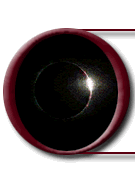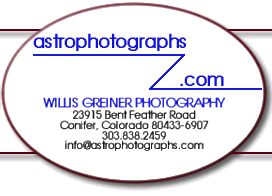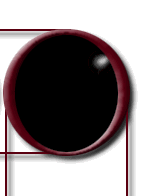|
Note -- you have reached the original astrophotographs.com website. Thanks very much for visiting. Logo contact information has been updated (i.e. we moved to Taos, NM) as below:
Willis Greiner
12 Rabbit Valley Road / P.O. Box 1515
El Prado, NM 87529
303-903-8996 or 575-758-3670
taosastronomer@gmail.com
You may also want to visit Willis' new astronomy site at: taosastronomer.com/
"Lesson
for Hyakutake (a letter)"
Dear Jerry,
I'm going to include some comet photos as well as blabbermouthy
verbiage. Also, I'll include only one star chart, as they
take up a ridiculous amount of memory.
Here's a synopsis of what I would do with this subject in
the field:
Astronomical photography isn't that
difficult.
A) Discussion of full knowledge of cameras and film.
|
(Use the scene of the T-Rex at the
kid's car in Jurassic Park as an example as to what occurs
when you use bright light. I'll bet the T-Rex didn't have
very good night vision after that encounter! He probably
mistook the lawyer-scum for some sort of small dinosaur
prey, don't you think?? ) |
1) Depth of field vs. f/stop vs. quality of optics. You don't
need much depth of field (stars and comets are located at positions
of infinity), but accept the fact that all optics (even Nikon
or the ancient Pentax screw-mount-lens manual equipment used
here) definitely cooperate best if stopped down a bit. I recommend
1/2 to 1 stop down. If the lens is a f/1.8 (like mine), then
stop to f/2, and focus to infinity. It's best to make sure (during
the day!) that "infinity" is really infinity with whatever lens
you wish to use. When the comet was gigantic (see chart enclosed)
I used either a 55mm lens or the 28mm wide angle -- it didn't
seem to have as much light transmission, even at similar f/stops
-- so I ended up preferring the 55mm lens, my old favorite.
By the way, note the age and grandfatherly nature of my optics
and the resultant photos. Once again, it proves the lack of
need for all the "new" highfalutin' b______t automatic
optical systems. For any budding photographers in the group,
I recommend selling their automatic cameras (or giving them
to me or the instructors -- we could "dispose" of them for the
children!) and then visiting the local pawn shops. This might
make a fun field trip, as a matter of fact. Steve could hold
an art class on the inner-city streets of Cleveland.
2) The need for a lockable cable release, camera set on "B."
3) Film speed discussion vs. reciprocity failure phenomena.
The first few seconds of an exposure are the most effective
at gathering light, which is what astronomical photography is
all about. After time (measured in only minutes) the film's
ability to gather the light of an object (stars, comets, etc.)
is superseded by the film's (unfortunate) ability to gather
background light. Conclusion -- keep the exposures 5 minutes
or less, with ASA 1200-ASA 3200 film at f/2-f/4.
B) Discussion of the "correct" method of observation and recording.
1) Jerry, this is a long subject. Perhaps you can glean some
idea by looking at the enclosed chart and attached verbiage.
By copying this approach your students should at least have
a good base of the methodology. It's just like any other observational
science, so all of your Biological methods are a perfect fit.
2) PLEASE DEMAND the use of red filters (tissue paper or whatever)
over the flashlights so as to keep the pupils open and the viewing
and observing alive. (Use the scene of the T-Rex at the kid's
car in Jurassic Park as an example as to what occurs when you
use bright light. I'll bet the T-Rex didn't have very good night
vision after that encounter! He probably mistook the lawyer-scum
for some sort of small dinosaur prey, don't you think?? -- Honestly,
I wish he had consumed those obnoxious kids as well, but not
Laura Dern!) Again, dark-adaptation of the eyes is pivotal.
C) Let's take pictures! (Just like Barry stated when we first
"met" Brian Martin going over the rock at Skull Rapid: Willis
-- "He's in trouble, what do we do?" Barry -- "Take pictures!")
1) Place (manual) camera on tripod, the lower to the ground
(more stable) the better.
2) Choose lens, load film -- (no s__t, but I've made this
mistake!), put on "B," attach cable release, stop down 1/2
stop, put on real infinity (see above "test"), expose (bracketing
from say 1-5 minutes at f/2 to f/4). No f___ing lights or
other distractions during exposures -- perhaps spread the
kids out. Make records of the exposures -- see my log for
"proper" method. One other method I use is to actually place
a record album (what's that???) in front of the camera, THEN
open the lens, THEN move the album away. Reverse the method
to shut shutter and end exposure. The album (or whatever is
convenient) becomes the shutter. Reason -- elimination of
mirror vibration during first "nanosecond" of exposure (see
above discussion of film's sensitivity). I time exposures
by counting out loud but you can use a glowing watch or stopwatch
as well.
3) Another idea here is to make sure they rewind the film
after the session. I am often so excited with the potential
results (and often tired) that I have ruined film by opening
the camera. It wouldn't hurt to just very methodically rewind
and label the film right there and then. Then "tighten" up
the charts, write visual comments (with all appropriate background
info -- including name of observer and date -- and finish
up. If you plan on doing more photography later in the evening
put a plastic bag over the camera for dew prevention. It's
important to keep all the stuff the ambient outside temperature,
so the film doesn't fog, etc. Make sure all optics are ambient
as well.
Hope all of this is helpful -- have fun -- wish I could be
there!
Peace, s.Willis
|






















